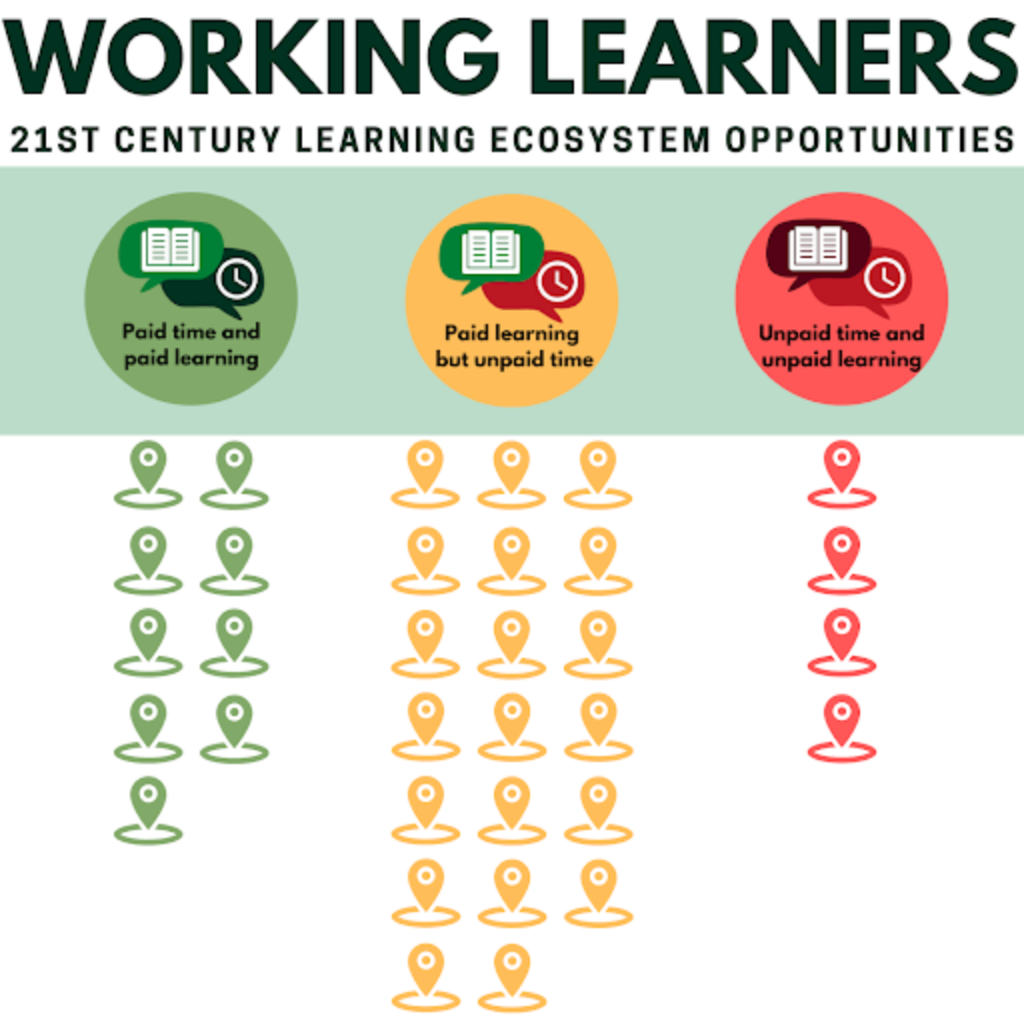
By the 21CLEO Research Team
From the beginning of our research, we have been asking what supports help frontline service workers succeed in employer-sponsored education and training initiatives. Whether working learners were paid for participating was one of the earliest questions that we asked during interviews. We wondered whether being paid for formal learning would be an incentive for engaging in a course, training, or credentialing opportunity. After interviewing 27 working learners (six of whom we interviewed multiple times), we’ve found that the answer to that question is complex. We initially identified four basic categories of how working learners were financially supported (or not) for their learning.
- Paid learning/paid time: The formal education or training initiative is paid for by the employer or by another organization. The employer also pays the working learner their hourly wage during the time spent in class, training, or some other form of recognized learning.
- Paid learning/unpaid time: The formal education or training initiative is paid for by the employer or by another organization. The working learner takes class on their own time.
- Unpaid learning/paid time: The working learner must pay for the class. The employer allows the working learner to do classwork while on the clock.
- Unpaid learning/unpaid time: The working learner pays for the class. The working learner takes class on their own time.
Three of these levels of support (or lack of support) were reflected in the experience our participants described. Some individuals participated in multiple education and training initiatives that differed in how they were supported. A few interviewees did not share information about whether their learning was paid for or if they were able to learn while on the clock. See figure 1 to see how the experiences of our participants are distributed across these categories.

Paid learning/paid time
The data indicate that most of the working learners we interviewed participated in education and training initiatives paid for by an employer or some other mediator of education or training such as a workforce organization. Of those, nine individuals were paid for the time they spent in class. A closer look at the interview data indicates that on-the-clock learning typically occurred when the content was required for employment. These included formal classes as well as activities such as a short online course about HIPAA regulations for those working in healthcare or a food service employee watching a training video on how to complete certain tasks.
A participant working at a retirement community said,
They pay for the class. They’re paying her [nursing director] to come in and take hours from doing her actual normal job. [B]ut then they’re paying us to sit through the classes. I got paid five hours for sitting in a class and having them go over everything….It’s like getting paid for going to school.
Another participant, working in food service, explained that she watches training videos on the clock to help her learn how to do specific tasks, but only when they aren’t busy. She said,
I watch [training] videos. I do what is needed from the videos. I’ve watched the video as I worked on the [ice cream] machine. But [I] haven’t got a chance watching more videos because we started to get more busy because we opened the drive-thru now.
In another case, a participant working in hospitality conducted most of her learning outside of work hours (what we categorized as unpaid time), but she was allowed to use the company’s computer and take time during her workday to engage in LinkedIn courses when the material directly related to her job and helped her be a better employee. These courses were paid for through her workforce development office. She explained,
I can take them on company time because it’s something that I’m using to enhance the company and my team. It wasn’t like it was something like my own personal goals that I was doing. It was something that they considered to be for the company.
A final set of circumstances around paid learning and paid time arose at one of our research locations, which was a large airport. Employees were given the opportunity to take an on-site English language course even though it was not a requirement for employment. The course was paid for by the airport commission on behalf of the many employers at the airport and as part of their efforts to attract and retain employees, as well as part of the goal of improving customer ratings. A few of the employers paid their employees for the time they spent in class, although some did not. This situation will be explored in the next blog post.
Paid learning/unpaid time
The most common scenario (n=20) was for learning to be paid for, but working learners had to do it on their own time. This represented a significant commitment on the part of the working learners. How this happened was also not as straightforward as it might first appear and circumstances differed for each context we looked at. For example, the English language learners working at the airport had to come in early, stay late, or come in on their day off. Those who came in on their day off not only had to travel; they also had to pass through airport security to get to class.
An employee at a large transit company earned her Bachelor’s degree through a tuition reimbursement program and later earned a supervisory certificate also paid for by her company. She paid for an additional course herself. In all cases, she had to find time to study outside of work and noted that her employer and instructors made it clear that school work was not to be done at work with the exception of the final projects, which aligned with her day-to-day work responsibilities.
In another example, a food service worker had to take courses on his own time, but he was able to participate in an internship within his company as a way to explore a potential career path. In his case, the formal learning in his course was paid for but off-the-clock. In contrast, the time he spent on his on-the-job learning in the internship was paid.
In several other cases, class time was not paid for, but the participants were able to use their work time to complete assignments that drew on their work. As one participant noted,
… it’s been interesting being in logistics in the office setting because [while] on the clock I interviewed a couple of my supervisors for my college class. And there I was getting paid to talk to them so I could do my homework. And I was like, am I going to be in trouble for this? But it’s my boss. So clearly, I’m not. She scheduled me to talk to her during the middle of my work day.
Our data show that even when learning is paid for there is a range of support giving the participants qualitatively different experiences depending on the program they were in. For example, one participant reported that the courses were paid for as were all materials, and they were even provided with a laptop. A participant working in a pharmacy said her classes, books, and test fees to become a pharmacy technician were paid for, but she had to take the classes on her own time. Other working learners received access to an online class but had to access it using their own computer and internet. Another participant indicated that she would have liked to take advantage of more of the education and training initiatives offered by her employer on her own time, but she was unable to access the proprietary online program at home.
Regardless of where they were employed, those working learners who were learning on their own time had to fit that learning into their daily lives in some way. They credited the support of family members, and they developed time management skills. These individuals indicated that engaging in learning after putting in a full work week and along with other responsibilities was stressful, but they believed it was worth it.
Unpaid learning/unpaid time
Only four working learners indicated that they paid for their own coursework. What is interesting is that they were participating in the courses in addition to employer-supported education and training initiatives. Of these individuals, two were in the transitional studies (pre-college) program at a community college, which offers a low-cost program and tuition assistance. They were also working and participating in the learning required for their specific jobs. Of the other two, one was participating in paid, on-the-clock learning opportunities at the suggestion of her manager so that she could move into a supervisory role. At the same time, she was engaged in independent learning on her own time. She described her self-initiated learning in this way:
I have signed up for a foreign language…I’m learning Korean….I fell in love with the culture first back in 2010….I fell in love with my first K drama from my cousin. She showed it to me and I just fell in love with the culture, the music, everything. I kind of want to learn the language now because it’ll be fun to not have to watch the shows with the English subtitles and everything.
Similarly, the fourth participant was paid for the time she spent learning the necessary information to perform her job, but she also engaged in unpaid learning during her own time to develop her interest in nutrition – a field she was interested in entering in the future.
Conclusion
Paid learning, meaning education and training initiatives paid for by an employer or some other interested party, was the norm among our participants. This most likely reflects a bias of the research in that we recruited participants through employer-supported initiatives. Paid time for learning generally occurred only when the training was integral to the job. All other learning was off-the-clock, even if the learning was intended to move a working learner along the career path. Study participants indicated that because the cost of taking a course or entering a program was an issue, paid learning and reimbursement made participation more attractive even when the course or training happened off the clock or they were not compensated for time spent.
One thing to note is the issue of equity; paid learning on unpaid time was possible only for those working learners whose lives had the extra space and support needed to devote to learning, whether for a current job or a perceived future job. Well-qualified and committed employees who want to participate in paid learning but who can’t for any number of reasons (such as family obligations or multiple jobs) are not necessarily able to do so. As such, the expectation that individuals engage in learning initiatives even when that time for learning is unpaid for is one way that inequity can be perpetuated. This inequity could be along race lines, gender lines, or socioeconomic status.
As you now see, the answer to the question of whether paid learning and paid time is needed to help learners be successful is complex. Paid learning gains entry, but it may not be enough to carry a working learner to success. Educational and training initiatives that are paid for, but unconnected to a current job or a clear career path may not be sufficient for job advancement. While paid time may not be required for successful learning and career growth, integrating learning into work appears to be more likely to positively influence success. That integration could be that working learners are being paid for the time they spend in class, or it could be that they are able to bring what they are learning to bear on the work they are doing. As noted by Upskill America and Jamie S. Fall in 2017, “The bottom line is that companies can either enable workers to better themselves or be an obstacle so they can’t.” Our findings illustrate how paid time and paid learning matter in the lives of working learners.



